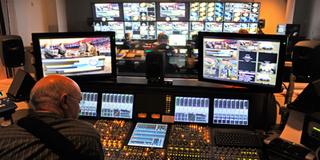The Evolving Needs of Regional Sports Networks
LOS ANGELES—Upgrading a control room is increasingly becoming an event that happens with an eye on the not-so-distant future. The build-out at Time Warner Cable SportsNet and TWC Deportes, and later SportsNet LA, happened in two phases that were two years apart, with the second having been planned as an addition to the first.

NASCAR Productions’ HD facility in Charlotte, N.C. “When we did the original build-out for TWC SportsNet and TWC Deportes in 2012, we left enough square footage to build another studio down the line, which ended up basically doubling the equipment complement in the process,” said Mark Coleman vice president, operations for TWC Sports Regional Networks, with the additions being four Sony 2500 cameras, the Calrec Artemeis, four edit rooms with Final Cut Pro or Adobe Premiere, with staffing space and other additional capacity.
“Actually, we were finishing the original TWC networks with our systems integrator, Diversified Systems Inc., when it was announced that SportsNet LA was going to be launched,” said Coleman. “We didn’t miss a beat. We had the first two networks up and running during the second build-out.”
A MORE ORGANIC APPROACH
TWC is still working with DSI and the University of Florida is still working with BeckTV, though such liaisons don’t always continue. In other control rooms, like NASCAR Productions’ fully file-based, HD facility in Charlotte, N.C., the approach to system enhancements is more organic; having worked in 2009 with CEI Engineering of Newington, Va., on the initial install, the staff opted to conduct its system upgrades in-house moving forward.
For example, last January, NASCAR Productions installed Levels Beyond, a media asset management and automation product. “We’re the largest motorsports library in the world, and through Levels Beyond, Fox Sports and NBC have access to our archives,” Steve Stum, vice president of operations and technical production at NASCAR Productions.
At the track, NASCAR gathers content from the Sprint Vision jumbotrons, ENG, clean feeds, dirty feeds, in-car cameras and, soon, 48 HD POV cameras that will be installed along pit road. “All of that content comes back here to Charlotte following every NASCAR race,” Stum said, “via satellite, fiber, or on hard drives, which we call ‘sneakernet,’ that someone brings back from a track. That’s 300 to 400 hours of content a week.”
And Levels Beyond—which runs on four production servers, one staging server and nine transcoding servers—facilitates the massive ingest into a library with more than 220,000 hours of content and more than 800,000 assets—which is part of why NASCAR’s needs evolve more than change. “We’re constantly upgrading,” Stum said.
Get the TV Tech Newsletter
The professional video industry's #1 source for news, trends and product and tech information. Sign up below.
